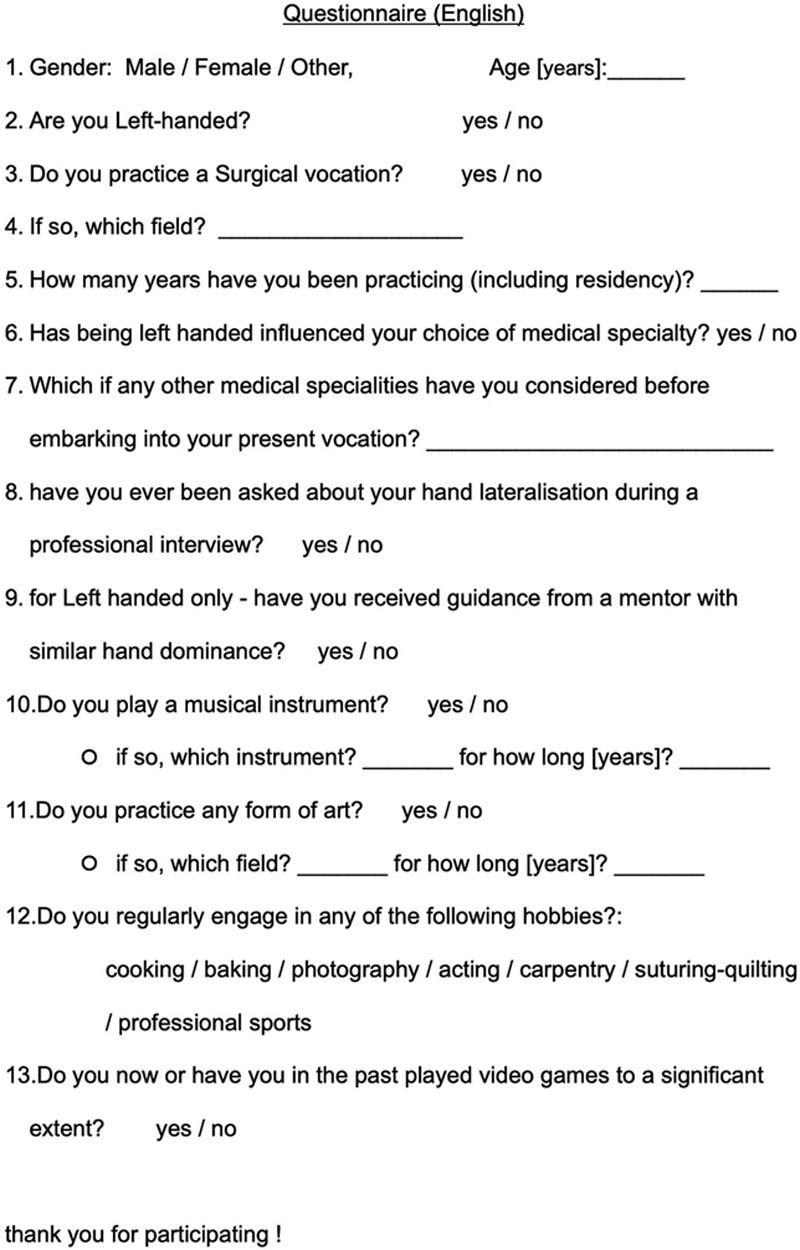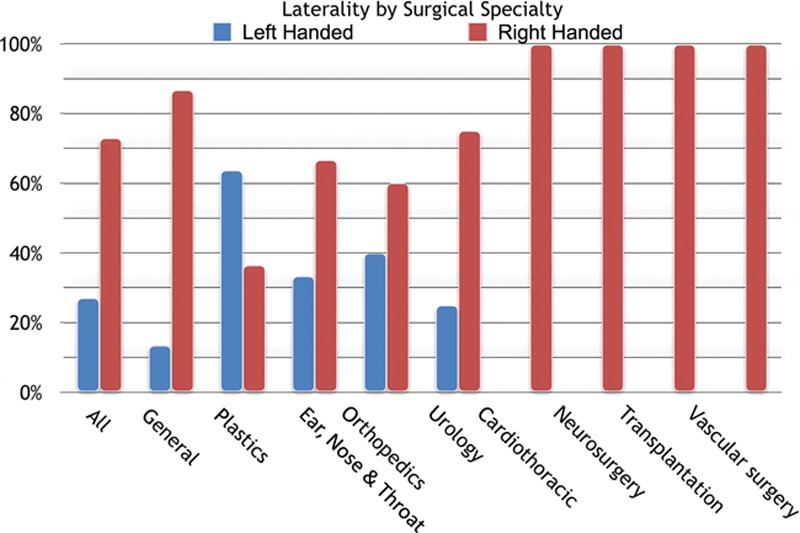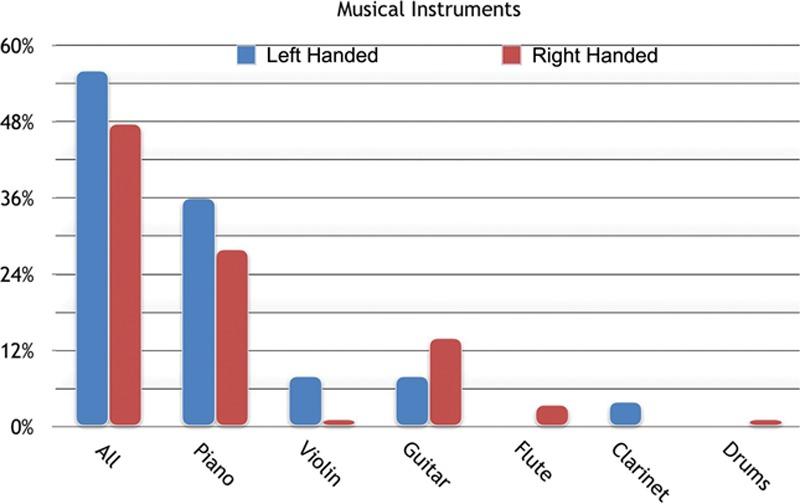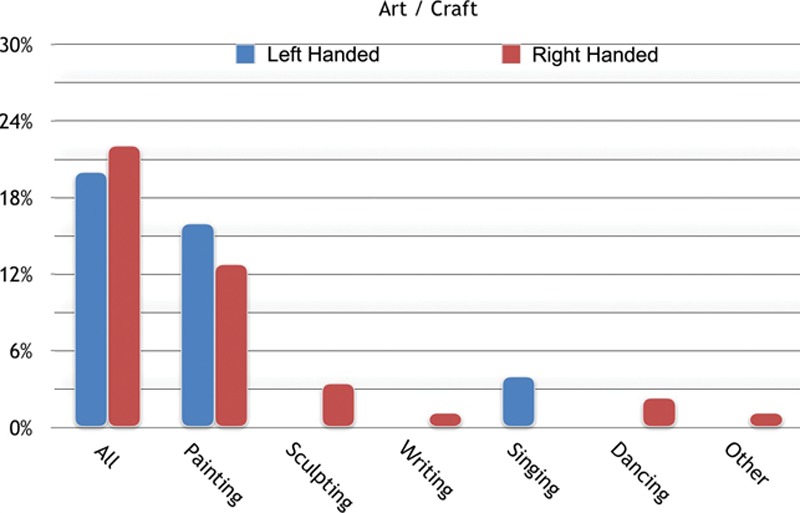Abstract
Background:
Left hand dominance is a minority trait historically regarded as disadvantageous for surgeons. Contemporary scientific literature and folklore have shed new light on left handedness as a “boutique trait” and possible marker of gifted and exceptional individuals. Our subjective impression that left handedness is prevalent in the unique field of plastic surgery raised questions regarding the scope and possible causality of this phenomenon.
Methods:
One hundred eleven medical doctors in our medical center filled out a 13-item questionnaire regarding hand dominance, medical speciality, and various creative outlets or hobbies.
Results:
Sixty-four percent of the participating plastic surgeons were left handed (significantly higher than the approximate 12% of the general population; P = 0.007). Many of the left-handed doctors admitted to practicing musical instruments and various arts, crafts, and other hobbies.
Conclusions:
Plastic surgery is a unique profession requiring astute minds capable of creative and “outside-the-box” thinking; traits we have learned in recent decades may be particularly keen in left-handed individuals, perhaps suggest a causal relationship to the conglomeration of a majority of left-handed plastic surgeons.
INTRODUCTION
The prevalence of left hand dominance in the general population is estimated between 10% and 12%.1
For centuries, left handers have suffered unfair discrimination in a world designed for right handers.2 In many Latin languages, the word for the direction “right” means “correct” or “proper.” The Latin adjective “sinister” means “left” and “unlucky.”
But things have changed. Studies have shown that left handers’ brains are structured differently from right handers’ in ways that can allow them to process language, spatial relations, and emotions in more diverse and potentially creative ways.3 Anatomically, the corpus callosum was slightly but significantly larger in left handers than in right handers, and some believe that this contributes to their creativity.4
A larger number of left handers than right handers are especially gifted in music, art, and math.3 Some well-known examples are Albert Einstein, Isaac Newton, Paul McCartney, Michelangelo, and Rembrandt. Left handed (LH) people are also likely to be geniuses: 20% of all Mensa (high intelligence quotient [IQ] society) members report being lefties.
They are considered quicker thinkers than righties and can better handle large amount of stimuli, making them naturally better at sports and video games;5 cf, Rafael Nadal and Bill Gates.
Because many daily tasks are designed for right-handed (RH) people, LH individuals are inherently expected to adapt to a RH world. Possibly as a of result of this adaptation, LH individuals show a greater degree of ambidexterity.6
In the surgical field, left handedness is considered a disadvantage. Studies report that LH surgical trainees are thought to be less technically skilled than their RH counterparts.7–11
LH residents report lack of mentorship, anxiety about laterality, and faculty annoyance with their hand dominance in the operating room.10–13 Conventional surgical procedures and instrumentation are optimized for RH surgeons, requiring LH surgeons to reverse usual motion to perform even basic tasks. LH surgeons and LH surgical trainees have reported challenges in both open and minimally invasive surgery based on their lateral predominance.9,11,13,14
We believe that plastic surgery is a unique form of fine surgery, wherein being LH may well be an advantage.15
Instances where LH-oriented mentoring and guidance are absent in their training, may reduce LH plastic surgeons to relay on their natural ambidexterity, artistic mind, and creativity to adjust and perform complicated procedures.
As physicians in plastic surgery department, an unusual number of LH surgeons were observed. We decided to explore the chances of lefties to acquire fine surgical training in a surgical residency.
METHODS
A survey was conducted in the Rabin Medical center. Doctors, residents, and seniors were asked to answer our questionnaire (Fig. 1). Data were collected and statistically analyzed.
Fig. 1.

The questionnaire our participants were presented with, translated to English.
RESULTS
One hundred eleven medical doctors answered our Questionnaire. Seventy-two percent were males, with an average age of 37 and 7.2 average years of experience. Twenty-five (22.5%) were LH and 86 (77.5%) were RH (higher ratio of left handedness compared with 12% in the general population; P = 0.04). Forty-three percent practiced surgical professions, which included general surgery, orthopedic surgery, urology, neurosurgery, vascular surgery, ear, nose, and throat (ENT), and plastic surgery. Eleven (9.9%) were plastic surgeons, and of those 64% were LH (Fig. 2). Plastic surgeons comprised 54% of the LH surgeons in our study.
Fig. 2.

Laterality by surgical specialty, a graph depicting the proportion of right and left hand dominance in all and each surgical field.
One doctor, that is, <1%, stated that left handedness influenced his career choice, which was also issued at his admission committee.
When asked whether the surgical training was guided by a same-handed mentor, none approved.
When investigating their hobbies, honed crafts, art forms, and musical instruments, we found that 56% of LH played music, most of them on the piano, comparing to 47.6% of the RH (P = 0.23) (Fig. 3). Twenty percent of lefties found art important and mastered it during their life, with a similar ratio at the righties (Fig. 4). When asked about other fields of interest, 28% of lefties like cooking, 16% photography, and 28% practice professional sport, compared with 25%, 10%, and 20% of the righties, respectively (Fig. 5). The last inquiry about video games found 44% of LH and 30% of RH played regularly. Overall, lefties engaged in hobbies and video games more than righties, to just short of a statistically significant degree (P = 0.06).
Fig. 3.

Musical instruments, a graph depicting incidence among right- and left-handed participants of practicing any and each musical instrument.
Fig. 4.

Arts and crafts, a graph depicting incidence among right- and left-handed participants of practicing any and each art or craft.
Fig. 5.

Hobbies, a graph depicting incidence among right- and left-handed participants of practicing any and each hobby.
DISCUSSION
It has been the subjective observation of the authors that left handedness is more prevalent among plastic surgeons when compared with other surgeons, other medical doctors entirely, and the general population.
This is strongly corroborated here, given 64% of plastic surgeons in the survey were left handed (when compared with up to 12% of the population; P = 0.007), widely exceeding every other specialty, none of whom approached 50%.
Limitations and Bias
Notably, our study was performed in a single center, limiting cohort size. The response rate among physicians was 100% in the department of plastic surgery, and although the vast majority of other physicians we could approach was prone to participate, it was not feasible to quantify their overall response rate. Regarding the authors of this study, we are obligated to state that 50% are LH individuals, which while artistic and handsome, diligently kept true to uphold academic objectivity.
The findings here show a consistent trend toward mastery or arts, crafts, and musical instruments among LH physicians.
Rooted in present-day folklore, the phrase “Left Handed - Right Minded” depicts a neurophysiologic anecdote, regarding cerebral hemisphere dominance, where right hand dominant individuals have a 95% likelihood of left-hemisphere dominance and left hand dominant individuals have a 50% chance of left/right-hemisphere dominance.16
Notably, the right hemisphere has historically been implicated in creative thinking.17
CONCLUSIONS
Regarding surgical residencies as a whole, the growing awareness of surgical training programs to the needs of LH trainees may serve to customize adequate mentoring and technical skill teaching.18
In the unique field of plastic surgery, the unusually high prevalence of LH surgeons both render special training and mentoring moot and may shed light onto the typecast of creative, innovative all-around surgeon, and the prominent LH individual as well.
The growing trend of appreciating the merits of lefties—as artistic, creative, and innovative “outside-the-box” thinkers—seems to correlate with many of our observations. These unique sought out qualities conglomerate in the comprehensive tool-chest of the plastic surgeon.
Footnotes
Published online 24 January 2020.
Disclosure: The authors have no financial interest to declare in relation to the content of this article.
Tamir Shay and Tal Kaufman have contributed equally to this work.
REFERENCES
- 1.Papadatou-Pastou M, Martin M, Munafò MR, et al. Sex differences in left-handedness: a meta-analysis of 144 studies. Psychol Bull. 2008;134:677–699. [DOI] [PubMed] [Google Scholar]
- 2.Santrock JW. A Topical Approach to Life-Span Development. 2016:8th edition New York, NY: McGraw-Hill Education; 146–172. [Google Scholar]
- 3.McManus IC. Is is true that left-handed people are smarter than right-handed people? Scientific American Mind. 2012. [Google Scholar]
- 4.Driesen NR, Raz N. The influence of sex, age, and handedness on corpus callosum morphology: a meta-analysis. Psychobiology. 1995;23:240–247. [Google Scholar]
- 5.Cherbuin N, Brinkman C. Hemispheric interactions are different in left-handed individuals. Neuropsychology. 2006;20:700–707. [DOI] [PubMed] [Google Scholar]
- 6.Fagard J, Chapelain A, Bonnet P. How should “ambidexterity” be estimated? Laterality. 2015;20:543–570. [DOI] [PubMed] [Google Scholar]
- 7.Elneel FH, Carter F, Tang B, et al. Extent of innate dexterity and ambidexterity across handedness and gender: implications for training in laparoscopic surgery. Surg Endosc. 2008;22:31–37. [DOI] [PubMed] [Google Scholar]
- 8.Grantcharov TP, Bardram L, Funch-Jensen P, et al. Impact of hand dominance, gender, and experience with computer games on performance in virtual reality laparoscopy. Surg Endosc. 2003;17:1082–1085. [DOI] [PubMed] [Google Scholar]
- 9.Makay O, Icoz G, Ersin S. Surgeon’s view on the limitations of left-handedness during endoscopic surgery. J Laparoendosc Adv Surg Tech A. 2008;18:217–221. [DOI] [PubMed] [Google Scholar]
- 10.Schueneman AL, Pickleman J, Freeark RJ. Age, gender, lateral dominance, and prediction of operative skill among general surgery residents. Surgery. 1985;98:506–515. [PubMed] [Google Scholar]
- 11.Tchantchaleishvili V, Myers PO. Left-handedness–a handicap for training in surgery? J Surg Educ. 2010;67:233–236. [DOI] [PubMed] [Google Scholar]
- 12.Adusumilli PS, Kell C, Chang JH, et al. Left-handed surgeons: are they left out? Curr Surg. 2004;61:587–591. [DOI] [PubMed] [Google Scholar]
- 13.Lieske B. The left handed surgical trainee. BMJ. 2008;337:a2883. [DOI] [PubMed] [Google Scholar]
- 14.Herrero-Segura A, López-Tomassetti Fernández EM, Medina-Arana V. Technical modifications for laparoscopic cholecystectomy by the left-handed surgeon. J Laparoendosc Adv Surg Tech A. 2007;17:679–685. [DOI] [PubMed] [Google Scholar]
- 15.Rohrich RJ. Left-handedness in plastic surgery: asset or liability? Plast Reconstr Surg. 2001;107:845–846. [DOI] [PubMed] [Google Scholar]
- 16.Rogers LJ, Andrew R. Comparative Vertebrate Lateralization. 2002Cambridge: University Press. [Google Scholar]
- 17.Mihov KM, Denzler M, Förster J. Hemispheric specialization and creative thinking: a meta-analytic review of lateralization of creativity. Brain Cogn. 2010;72:442–448. [DOI] [PubMed] [Google Scholar]
- 18.Prasad NK, Kvasnovsky C, Wise ES, et al. The right way to teach left-handed residents: strategies for training by right handers. J Surg Educ. 2018;75:271–277. [DOI] [PubMed] [Google Scholar]


